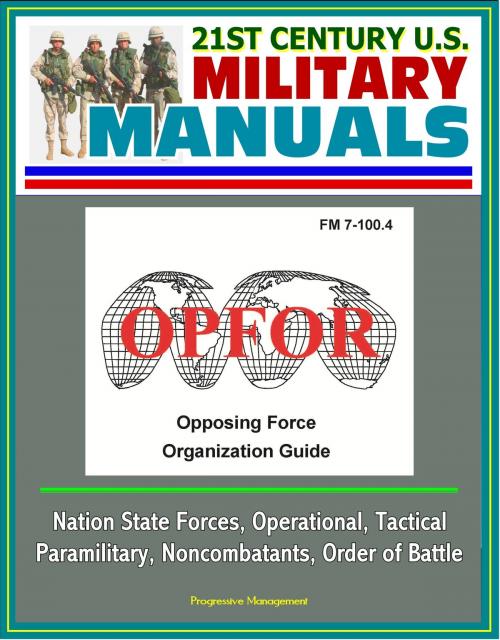21st Century U.S. Military Manuals: OPFOR Opposing Force Organization Guide (FM 7-100.4) - Nation State Forces, Operational, Tactical, Paramilitary, Noncombatants, Order of Battle
Nonfiction, History, Military, Strategy| Author: | Progressive Management | ISBN: | 9781311963956 |
| Publisher: | Progressive Management | Publication: | July 1, 2014 |
| Imprint: | Smashwords Edition | Language: | English |
| Author: | Progressive Management |
| ISBN: | 9781311963956 |
| Publisher: | Progressive Management |
| Publication: | July 1, 2014 |
| Imprint: | Smashwords Edition |
| Language: | English |
This manual is one of a series that describes an opposing force (OPFOR) for training U.S. Army commanders, staffs, and units. These manuals outline an OPFOR that can cover the entire spectrum of military and paramilitary capabilities against which the Army must train to ensure success in any future conflict.
Applications for this series of manuals include field training, training simulations, and classroom instruction throughout the Army.
Training U.S. forces for the contemporary operational environment (COE) requires a different kind of OPFOR from that of the past. The OPFOR must be less predictable and not based on the armed forces of a particular country or non-state actor. In today's world, the U.S. Army must be prepared to go into any operational environment (OE) and perform its full range of missions.
Chapter 1 - OPFOR ROLES AND RELATIONSHIPS IN TRAINING * OPFOR for the Contemporary Operational Environment * Role in Training * Tie-In with Other Manuals in the FM 7-100 Series. * Chapter 2 - ADMINISTRATIVE FORCE STRUCTURE * Section I - Nation-State Forces: Strategic Level * National-Level Command Structure * Service Components * Theater Headquarters * Section II - Nation-State Forces: Operational Level * Section III - Nation-State Forces: Tactical Level * Divisions * Maneuver Brigades * Battalions * Companies * Platoons * Aviation Units * Nondivisional Units * Section IV - Non-State Actors * Paramilitary Organizations * Noncombatants * Section V - Organizational Directories * Files for OPFOR Units * Folders for OPFOR Unit Files * Chapter 3 - TASK-ORGANIZING * Section I - Fundamental Considerations * U.S. Training Requirements * OPFOR Doctrine * Section II - Nation-State Forces: Strategic Level * Supreme High Command * Strategic Framework * Section III - Nation-State Forces: Operational Level * Field Group * Operational-Strategic Command * Section IV - Nation-State Forces: Tactical Level * Tactical Groups * Detachments * Integrated Fires Command * Integrated Support Command * Internal Task-Organizing * Special-Purpose Forces * Internal Security Forces * Section V - Non-State Actors * Insurgent and Guerrilla Forces * Other Paramilitary Forces * Noncombatants * Section VI - Exploitation of Noncombatants and Civilian Assets * By Military Forces * By Paramilitary Forces * Section VII - Unit Symbols for OPFOR Task Organizations * Section VIII - Building an OPFOR Order of Battle * Step 1. Determine the Type and Size of U.S. Units * Step 2. Set the Conditions * Step 3. Select Army Tactical Tasks * Step 4. Select OPFOR Countertasks * Step 5. Determine the Type and Size of OPFOR Units * Step 6. Review the AFS Organizational Directories * Step 7. Compile the Initial Listing of OPFOR Units for the Task Organization.3-24 * Step 8. Identify the Base Unit * Step 9. Construct the Task Organization * Step 10. Repeat Steps 4 through 9 as Necessary * Chapter 4 - EQUIPMENT OPTIONS * Baseline Equipment * Worldwide Equipment Guide * Appendix A * ADMINISTRATIVE FORCE STRUCTURE ORGANIZATIONAL DIRECTORIES LISTING * Volume I - Divisions and Divisional Units * Volume II - Nondivisional Units * Volume III - Paramilitary and Nonmilitary Actors * Volume IV - Other * Appendix B * BUILDING AN OPFOR TASK ORGANIZATION * Task Organization Example * Building from the Bottom Up * Appendix C * LOCAL INSURGENT ORGANIZATION FROM THE AFS ORGANIZATIONAL DIRECTORIES * Insurgent Organizations * Local Insurgent Organization Example * Appendix D * MOTORIZED INFANTRY COMPANY FROM THE AFS ORGANIZATIONAL DIRECTORIES * Infantry and Motorized Infantry Companies * Motorized Infantry Company Example * Appendix E * GUERRILLA HUNTER/KILLER COMPANY FROM THE AFS ORGANIZATIONAL DIRECTORIES. * Guerrilla Organizations * Guerrilla Hunter/Killer Company Example
This manual is one of a series that describes an opposing force (OPFOR) for training U.S. Army commanders, staffs, and units. These manuals outline an OPFOR that can cover the entire spectrum of military and paramilitary capabilities against which the Army must train to ensure success in any future conflict.
Applications for this series of manuals include field training, training simulations, and classroom instruction throughout the Army.
Training U.S. forces for the contemporary operational environment (COE) requires a different kind of OPFOR from that of the past. The OPFOR must be less predictable and not based on the armed forces of a particular country or non-state actor. In today's world, the U.S. Army must be prepared to go into any operational environment (OE) and perform its full range of missions.
Chapter 1 - OPFOR ROLES AND RELATIONSHIPS IN TRAINING * OPFOR for the Contemporary Operational Environment * Role in Training * Tie-In with Other Manuals in the FM 7-100 Series. * Chapter 2 - ADMINISTRATIVE FORCE STRUCTURE * Section I - Nation-State Forces: Strategic Level * National-Level Command Structure * Service Components * Theater Headquarters * Section II - Nation-State Forces: Operational Level * Section III - Nation-State Forces: Tactical Level * Divisions * Maneuver Brigades * Battalions * Companies * Platoons * Aviation Units * Nondivisional Units * Section IV - Non-State Actors * Paramilitary Organizations * Noncombatants * Section V - Organizational Directories * Files for OPFOR Units * Folders for OPFOR Unit Files * Chapter 3 - TASK-ORGANIZING * Section I - Fundamental Considerations * U.S. Training Requirements * OPFOR Doctrine * Section II - Nation-State Forces: Strategic Level * Supreme High Command * Strategic Framework * Section III - Nation-State Forces: Operational Level * Field Group * Operational-Strategic Command * Section IV - Nation-State Forces: Tactical Level * Tactical Groups * Detachments * Integrated Fires Command * Integrated Support Command * Internal Task-Organizing * Special-Purpose Forces * Internal Security Forces * Section V - Non-State Actors * Insurgent and Guerrilla Forces * Other Paramilitary Forces * Noncombatants * Section VI - Exploitation of Noncombatants and Civilian Assets * By Military Forces * By Paramilitary Forces * Section VII - Unit Symbols for OPFOR Task Organizations * Section VIII - Building an OPFOR Order of Battle * Step 1. Determine the Type and Size of U.S. Units * Step 2. Set the Conditions * Step 3. Select Army Tactical Tasks * Step 4. Select OPFOR Countertasks * Step 5. Determine the Type and Size of OPFOR Units * Step 6. Review the AFS Organizational Directories * Step 7. Compile the Initial Listing of OPFOR Units for the Task Organization.3-24 * Step 8. Identify the Base Unit * Step 9. Construct the Task Organization * Step 10. Repeat Steps 4 through 9 as Necessary * Chapter 4 - EQUIPMENT OPTIONS * Baseline Equipment * Worldwide Equipment Guide * Appendix A * ADMINISTRATIVE FORCE STRUCTURE ORGANIZATIONAL DIRECTORIES LISTING * Volume I - Divisions and Divisional Units * Volume II - Nondivisional Units * Volume III - Paramilitary and Nonmilitary Actors * Volume IV - Other * Appendix B * BUILDING AN OPFOR TASK ORGANIZATION * Task Organization Example * Building from the Bottom Up * Appendix C * LOCAL INSURGENT ORGANIZATION FROM THE AFS ORGANIZATIONAL DIRECTORIES * Insurgent Organizations * Local Insurgent Organization Example * Appendix D * MOTORIZED INFANTRY COMPANY FROM THE AFS ORGANIZATIONAL DIRECTORIES * Infantry and Motorized Infantry Companies * Motorized Infantry Company Example * Appendix E * GUERRILLA HUNTER/KILLER COMPANY FROM THE AFS ORGANIZATIONAL DIRECTORIES. * Guerrilla Organizations * Guerrilla Hunter/Killer Company Example















